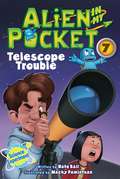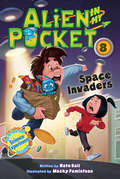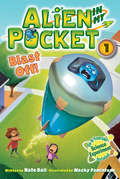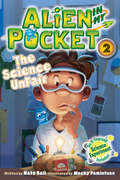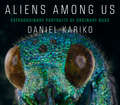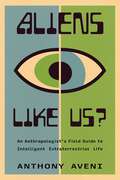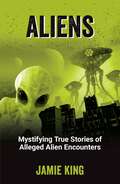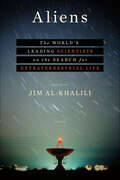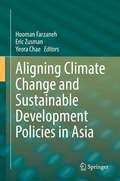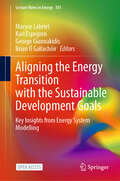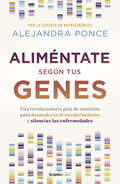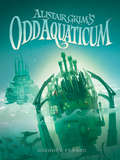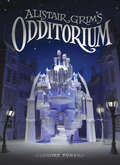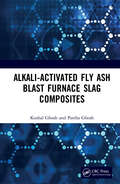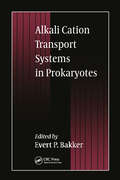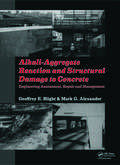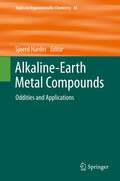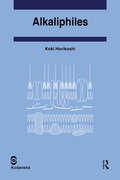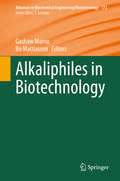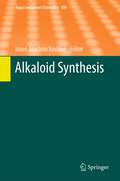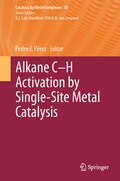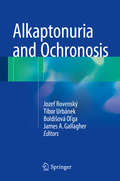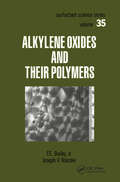- Table View
- List View
Alien in My Pocket #7: Telescope Troubles
by Macky Pamintuan Nate BallIt's Zack and Amp to the rescue in the seventh book in Nate Ball's beloved Alien in My Pocket series! With a tale that's sure to tickle the funny bone and a do-it-yourself hover-ship science experiment, it's an adventure readers are sure to enjoy.<P><P>Life has been no picnic since Amp crash-landed his spaceship through Zack McGee's window. But when Amp takes up stargazing, he makes a huge discovery that will take their zany adventures to the next level. It appears that the Erdian aliens are at it again! The alien invasion of Earth is in progress, and it's up to Zack, Amp, and Olivia to leap into action. But this time it'll take more than a little gadgetry and a few white lies to get Amp out of trouble and to save the world!Like every book in the Alien in My Pocket series, Telescope Troubles mixes Common Core-aligned science and safe, hands-on experiments with a hilarious story that young readers will love. Publishers Weekly said of Alien in My Pocket: Blast Off!: "With its screwball comedy and lively dialogue, the novel gives readers the opportunity to laugh as they learn."Correlates to the Common Core State Standards in the English Language Arts
Alien in My Pocket #8: Space Invaders
by Macky Pamintuan Nate BallIt's the thrilling conclusion to the Alien in My Pocket series! With a page-turning plot, plenty of fun science facts, illustrations throughout, and a do-it-yourself, hands-on experiment at the end, this is an appealing chapter book series for young readers. And it's all from the amazing brain of MIT graduate Nate Ball, host of PBS's Emmy Award-winning Design Squad series.Zack has grown fond of his troublesome buddy, Amp, since the four-inch-tall alien crash-landed his spaceship through Zack's bedroom window. They've gotten into more than their fair share of trouble together, but they've always invented a way out of it. Until a fleet of ships from Amp's home planet filled the sky and started firing its weapons. Zack and Amp have to do the thing most kids only dare imagine--save the world!Correlates to the Common Core State Standards in English Language Arts
Alien in My Pocket: Blast Off!
by Macky Pamintuan Nate BallThe adventure begins in this exciting new chapter book series, complete with a do-it-yourself science experiment! When a four-inch-tall alien crash-lands through Zack McGee's bedroom window, Zack is sure he's about to become the first victim in a new War of the Worlds. But when the alien turns out to have weapons that are more ticklish than terrifying, Zack realizes that rather than protect the world from the alien it's up to him to protect the alien in his pocket from the world.With illustrations on every spread, a how-to on launching a rocket, fun scientific facts, and the hilarious adventures of Zack and Amp, this book is the perfect gift for any young reader!Supports the Common Core State Standards
Alien in My Pocket: The Science UnFair
by Macky Pamintuan Nate BallThe must-read second book in the Alien in My Pocket series. Zack and Amp are back and up to even more trouble in this hilarious story, complete with a do-it-yourself science experiment!Ever since Amp crash-landed his spaceship through Zack McGee's bedroom window, Zack's life has gotten crazier and his grades have gone from bad to worse. Who has time for homework when there's an alien invasion to stop? But now Zack's up against his greatest challenge yet--the school science fair. If Zack doesn't get an A on his project, he's going to flunk the class. Luckily, Zack has Amp around to help, but when Zack's experiment turns out to be too good, he winds up in a whole different kind of trouble.Complete with many illustrations, a riveting plot, and fun scientific facts, this book is perfect for young readers!Supports the Common Core State Standards
Aliens Among Us: Extraordinary Portraits Of Ordinary Bugs
by Daniel KarikoWith more than sixty stunning photographs of pillbugs, silverfish, moths, and other household insects, Aliens Among Us depicts a hidden world flourishing in our homes. Over the course of his photography career, Daniel Kariko came to realize that many of his most stunning subjects could be found in his own subdivision in Greenville, North Carolina. Determined to show the rest of us that his experience is hardly unusual, Kariko utilizes a combination of a Scanning Electron Microscope and optical Stereo Microscope to achieve a portrait-like effect for insects and arthropods. Vibrant in color and surprising in personality, these images reveal such details as the glittering eyes of a horsefly, the strong legs of a centipede, and the fetching smile of a honeybee. Each photograph comes equipped with a full-body illustration from artist Isaac Talley, and fascinating character descriptions from entomologist Tim Christensen. Deftly blurring the lines of art and science, Aliens Among Us is the perfect guidebook for anyone interested in putting a face to the creepers under the couch.
Aliens Like Us?: An Anthropologist's Field Guide to Intelligent Extraterrestrial Life
by Anthony AveniIn this authoritative, accessible, and at times funny and irreverent work, distinguished anthropologist Anthony Aveni speaks to the trained astrophysicist and the curious layperson alike about a simple but previously unexplored question: Why do we assume aliens, if they are really out there, behave just like us?Aveni’s newest work departs from the usual scientific treatment of extraterrestrial intelligence by probing the historical and widely neglected anthropological record, which offers relevant analogous incidents of contact among terrestrial cultures. Beginning with theories of the evolution of life and culture advocated by astrobiologists, Aliens Like Us? explores how the Western cultural imagination is influenced by ways of knowing that are deeply embedded in the minds of the questioners—for example, how we consider the ownership of property, the idea of progress, and even the way we classify things. The lessons of anthropology offer not only value structures from other cultures that differ profoundly from our own but also testify to the diverse ways in which "alien" cultures interact.Finally, on the question of potential first contact, Aveni closes with a fascinating exploration of the image of extraterrestrials in popular culture that is derived in part from the hugely influential realm of science fiction.
Aliens: Mystifying True Stories of Alleged Alien Encounters
by Jamie KingThis intriguing anthology examines incidents that were so puzzling they led witnesses to draw one inevitable conclusion: that aliens really do exist. Inside you will discover some of the most mysterious reports of UFO sightings, close encounters and alien abductions from across the globe.
Aliens: Mystifying True Stories of Alleged Alien Encounters
by Jamie KingThis intriguing anthology examines incidents that were so puzzling they led witnesses to draw one inevitable conclusion: that aliens really do exist. Inside you will discover some of the most mysterious reports of UFO sightings, close encounters and alien abductions from across the globe.
Aliens: The World's Leading Scientists on the Search for Extraterrestrial Life
by Jim Al-KhaliliIn these lively and fascinating essays edited by theoretical physicist Jim Al-Khalili, scientists from around the world weigh in on the latest advances in the search for intelligent life in the universe and discuss just what that might look like. Since 2000, science has seen a surge in data and interest on several fronts related to E.T. (extraterrestrials); A.I. (artificial intelligence); and SETI (search for extraterrestrial intelligence). The debate has intensified over whether life exists outside our solar system, what that life would look like, and whether we’ll ever make contact.Included here are essays from a broad spectrum of the scientific community: cosmologists, astrophysicists, NASA planetary scientists, and geneticists, to name just a few, discussing the latest research and theories relating to alien life. Some of the topics include: If life exists somewhere in space, what are the odds that it evolves into something we would recognize as intelligent? What will space travel look like in the future, and will it all be done by cyborg technology? How long until we are ruled by robot overlords? (This is actually a serious consideration.) Are we simply a simulation in the mind of some supreme being, acting out a virtual reality game?For those who have ever wondered, Is there anybody out there? here are the latest theories and evidence that move us closer to answering that question.
Aligning Climate Change and Sustainable Development Policies in Asia
by Hooman Farzaneh Eric Zusman Yeora ChaeThis book provides policymakers, researchers, and other interested audiences with knowledge on how to quantify and integrate and advance co-benefits in their decisions. It begins with an introductory chapter that provides an overview of the concept of co-benefits. This followed by a section that details quantitative approaches to estimate co-benefits, particularly in cities. A third section presents a series of case studies from the energy sector in Northeast and Southeast Asia. A final section focuses on new perspectives on co-benefits from linking climate change with biodiversity, social justice, and through new models of co-innovation. The book is particularly timely as many countries in Asia seek to achieve objectives in the national climate policies and the Sustainable Development Goals (SDGs). The climate emergency poses an increasingly severe threat to the health and well-being of more than a billion people in Asia. Policymakers in the region have sought to curb this threat by adopting clean energy, energy efficiency, and other sectoral policies. In some cases, these policies can bring additional benefits beyond mitigating climate change. These so-called “co-benefits” --ranging from improved air quality to better health to socioeconomic equity--could not only offset the costs of climate mitigation but also make Asia’s development more sustainable. Yet all too frequently policymakers lack the analytical methods and practical experiences to incorporate co-benefits into their decisions. This has created difficulties in aligning climate and sustainable development policies in Asia.
Aligning the Energy Transition with the Sustainable Development Goals: Key Insights from Energy System Modelling (Lecture Notes in Energy #101)
by George Giannakidis Maryse Labriet Brian Ó Gallachóir Kari EspegrenThis open access book brings together concrete analyses from around the world, spanning various scales, that shed light on strategies for implementing essential energy and climate transitions within the broader context of UN Sustainable Development Goal (SDG) imperatives. Specifically, the book exemplifies the advancement, adaptation, and utilization of energy systems models to address intricate policy issues around pathways to achieve net-zero emissions, enhance energy security, optimize investments, and understand their societal implications. It explores the intricate connections between the SDGs concerning energy, climate action, and other developmental priorities such as employment and economic growth, industrial innovation, urban development, responsible consumption and production, and collaborative partnerships. Organized into four sections, the book illustrates the necessary adjustments of energy system models to guide SDGs, evaluates the role of modeling to advance both renewable energy and energy security, and showcases how energy systems are harnessed to engage with international, national, and local policymakers. This book is available open access under a Creative Commons Attribution 4.0 International License via link.springer.com.
Aliméntate según tus genes: Una revolucionaria guía de nutrición para desacelerar el envejecimiento y silenciar las enfermedades
by Alejandra PonceLa ciencia nos ha concedido la longevidad. ¿Cómo podemos disfrutar de ella? ¿Qué debemos hacer para gozar de una vejez saludable y libre de enfermedades? En este libro encontrarás las respuestas. No hay ningún plan de alimentación funcional para todo el mundo: lo que a unos les sienta bien, a otros puede hacerles daño. ¿Cómo se explica? Por el código genético, que es absolutamente único en cada persona. Alejandra Ponce, experta en nutrigenómica, una apasionante y pionera ciencia que une la genética y la nutrición, nos advierte que, contrario a lo que la medicina tradicional ha dictado, no es correcto seguir recomendaciones generales: hay que buscarun plan de alimentación adecuado para tus genes, de manera que goces hoy de una vida sana y que llegues a la vejez sin enfermedades. Aunque estamos programados genéticamente para presentar ciertos padecimientos, la combinación de una nutrición personalizada y un estilo de vida saludable hace posible retrasarlos o incluso silenciarlos para siempre. Este libro es una revolucionaria guía que te ayudará a convertir tu longevidad en años que se disfruten.
Alistair Grim's Odd Aquaticum (Alistair Grim #2)
by Greg Funaro"Dive head-, feet-, or face-first into this delicious danger." -- Kirkus Reviews, starred review When Grubb, an orphan and runaway chimney sweep, entered the wondrous world of the Odditorium, his life changed forever. Apprenticed to the mechanical marvel's strange proprietor, Alistair Grim, Grubb unfortunately must settle into his new position on the lam, as all of England is convinced that Alistair Grim is a villain. Grim, however, has come up with a plan to expose the real villain: Prince Nightshade, a wicked necromancer who wants the Odditorium's power source for himself. With the evil prince hot on their trail, Grim, Grubb and the rest of the Odditorium's crew embark on a perilous adventure to find the legendary sword Excalibur: the only weapon capable of penetrating Nightshade's magical suit of armor. As expected, their quest turns out to be anything but ordinary. Not only can the Odditorium fly, but it can also swim! And so the crew battens down the hatches and sets off on an underwater voyage to the otherworldly realm of Avalon, home to Excalibur. Along the way, they must battle a banshee assassin, sea monsters, and a witch who seeks revenge on Alistair Grim for stealing her magical objects. But that's not all. Unbeknownst to Grubb and the others, their fate has been written in an ancient Avalonian prophecy-a prophecy that holds the key to a destiny not even Alistair Grim could have imagined.
Alistair Grim's Odditorium (Alistair Grim #1)
by Gregory FunaroGrubb, age twelve (or thereabouts), has never known anything beyond his miserable existence as a chimney sweep, paid only in insults and abuse by his cruel master. All of that changes the day he stows away in the coach belonging to a mysterious guest at the inn that he is tasked with cleaning. Grubb emerges from Alistair Grim's trunk and into the wondrous world of the Odditorium. Fueled by a glowing blue energy that Grubb can only begin to understand, the Odditorium is home to countless enchanted objects and an eccentric crew that embraces Grubb as one of their own. There's no time for Grubb to settle into his new role as apprentice to the strange, secretive Mr. Grim. When the Odditorium comes under attack, Grubb is whisked off on a perilous adventure. Only he can prevent the Odditorium's magic from falling into evil hands???and his new family from suffering a terrible fate. Grubb knows he's no hero. He's just a chimney sweep. But armed with only his courage and wits, Grubb will confront the life-or-death battle he alone is destined to fight.
Alkali Activated Fly Ash: Blast Furnace Slag Composites
by Partha Ghosh Kushal GhoshThis book covers relevant synthesizing parameters, their interactions, and advantages of blending fly ash and blast furnace slag as source material, their relationship with mechanical properties and microstructure including guidelines to produce an optimal mix proportion. Further, it discusses related durability aspects, mechanical properties and reaction products and their inter-relationship. It explains phase characterization with XRD/SEM, change in the bond formulations with FTIR, FESEM and EDAX analysis. A mix design guideline based on empirical statistical concept has been put forward for professionals to manufacture customized activated fly ash composites in presence of slag. Aimed at graduate/senior undergraduate students, researchers in civil engineering, construction engineering, ceramics, material sciences, this book: Covers mechanical and microstructural properties, curing, durability of blended Alkali- activated composites with fly ash and blast furnace slag. Proposes a guideline for mix design on chemical compositions of ingredients, relationship of synthesizing parameters, workability, target strength. Describes sustainable green material manufacturing methodologies. Discusses issues like microstructural properties and reaction mechanism. Explores related modern experimental techniques like XRD, FTIR, MIP and so forth.
Alkali Cation Transport Systems in Prokaryotes
by E. P. BakkerAlkali Cation Transport Systems in Prokaryotes is the first book that brings together the physiological, structural, and molecular biological aspects of the transport of sodium, potassium, and ammonium across the bacterial cell membrane. Sodium translocation plays a major role in energy coupling of some prokaryotes, and much of the book is devoted to new and exciting developments in this field. Over 30 experts have contributed to this excellent reference for microbiologists, biochemists, molecular biologists, cell biologists, chemotherapists, and researchers interested in bioenergetics.
Alkali-Aggregate Reaction and Structural Damage to Concrete: Engineering Assessment, Repair and Management
by Geoffrey E. Blight Mark G AlexanderSince AAR was first identified in 1940, it has been a subject dominated by studies of the mineralogy of AAR-susceptible aggregates, the chemistry of the AAR and related reactions and laboratory tests used to diagnose AAR and predict potential future swelling. Civil and structural engineers have found the literature bewildering and difficult to appl
Alkaline-Earth Metal Compounds: Oddities and Applications (Topics in Organometallic Chemistry #45)
by Sjoerd HarderAna Torvisco, Karin Ruhlandt-Senge: Heavy Alkaline-Earth Metal Organometallic and Metal Organic Chemistry: Synthetic Methods and Properties.- Matthias Westerhausen, Jens Langer, Sven Krieck, Reinald Fischer, Helmar Görls, Mathias Köhler: Heavier Group 2 Grignard Reagents of the Type Aryl-Ae(L)n-X (Post-Grignard Reagents.- Cameron Jones, Andreas Stasch: Stable Molecular Magnesium(I) Dimers: A Fundamentally Appealing yet Synthetically Versatile Compound Class.- Robert E. Mulvey, Stuart D. Robertson: Modern Developments in Magnesium Reagent Chemistry for Synthesis.- Jean-François Carpentier, Yann Sarazin: Alkaline-Earth Metal Complexes in Homogeneous Polymerization Catalysis.- Mark R. Crimmin, Michael S. Hill: Homogeneous Catalysis with Organometallic Complexes of Group 2.- Tetsu Tsubogo, Yasuhiro Yamashita, Shū Kobayashi: Chiral Ca, Sr and Ba-catalyzed asymmetric direct-type aldol, Michael, and Mannich and related reactions.
Alkaliphiles
by Koki HorikoshiOne of the most fascinating aspects of alkaliphiles is their ability to maintain pH homeostasis under extreme environmental conditions. This work provides a treatment of alkaliphilic microbiology, supported by molecular studies on the genetics of alkaliphilic "Bacillus" strain. Genomic analysis of "Bacillus halodurans" C-125 has been started and the genes responsible for alkaliphily are described. In addition to a basic background of alkaliphiles, including discussions of cell structures, physiology and molecular biology, "Alkaliphiles" presents an analysis of extracellular enzymes. Research on numerous enzymes including alkaline proteases, starch-degrading enzymes, cellulases, mannan-degrading enzymes, and many others is described in depth with relevant industrial applications.
Alkaliphiles in Biotechnology (Advances in Biochemical Engineering/Biotechnology #172)
by Bo Mattiasson Gashaw MamoThis book is devoted to alkaliphiles, their microbiology, biotechnological applications and adaptive mechanisms. Alkaliphiles are extremophilic organisms that are adapted to thrive in alkaline environments. Over the years, a wide variety of alkaliphiles belonging to domain Bacteria, Archaea and Eukarya have been isolated and studied. These organisms use various adaptive mechanisms to thrive in ‘extreme’ alkaline environments, and some of these adaptive mechanisms are of immense importance to a range of biotechnological applications. In this book, readers will learn about the adaptive strategies of alkaliphiles in colonizing alkaline habitats, with a main focus on: (1) the production of enzymes that are active and stable in the high pH environment, and (2) the production of acids that decrease the pH of their immediate surrounding environment. Enzymes that are operationally stable at high pH (also known as alkaline active enzymes) are desirable in several applications such as detergent formulating and leather tanning processes, and they are among the major selling enzymes and the most important industrial enzymes. The growing demand in many existing and emerging biotechnological applications led to the discovery, characterization, engineering and evaluation of diverse types of alkaline active enzymes. In addition to the use of these fascinating enzymes in biotechnological applications, readers will discover the mechanisms of action and stability of these enzymes at extreme pH. Studies have shown that some alkaliphiles decrease the severity of the high pH of their media by producing substantial amount of organic acids, which could be of great interest in various applications presented in this book. In addition to enzymes and organic acids, other products of biotechnological importance such as carotenoids, bioactive substances, and chelators have also attracted researchers’ attention. Whole-cells of alkaliphiles have been used as food and feed, and are also useful in environmental applications such as in waste treatment and construction.
Alkaloid Synthesis (Topics in Current Chemistry #309)
by Hans-Joachim KnölkerLycopodium Alkaloids: Isolation and Asymmetric Synthesis, by Mariko Kitajima and Hiromitsu Takayama.- Synthesis of Morphine Alkaloids and Derivatives, by Uwe Rinner and Tomas Hudlicky.- Indole Prenylation in Alkaloid Synthesis, by Thomas Lindel, Nils Marsch and Santosh Kumar Adla.- Marine Pyrroloiminoquinone Alkaloids, by Yasuyuki Kita and Hiromichi Fujioka.- Synthetic Studies on Amaryllidaceae and Other Terrestrially Derived Alkaloids, by Martin G. Banwell, Nadia Yuqian Gao, Brett D. Schwartz and Lorenzo V. White.- Synthesis of Pyrrole and Carbazole Alkaloids, by Ingmar Bauer and Hans-Joachim Knölker.-
Alkane C-H Activation by Single-Site Metal Catalysis (Catalysis by Metal Complexes #38)
by Pedro J. PérezOver the past decade, much research effort has been devoted to the design and synthesis of new reagents and catalysts that can influence carbon-hydrogen bond activation, mainly because of the prospect that C--H activation could enable the conversion of cheap and abundant alkanes into valuable functionalized organic compounds. Alkane C-H Activation by Single-Site Metal Catalysis presents the current state-of-the-art development in the catalytic systems for the catalytic trans-formations of alkanes under homogeneous conditions. Chapter 1 offers a comprehensive summary of the main discoveries realized so far. Chapter 2 reviews the so-called electrophilic activation, initiated by Shulpín in the late 60s, and the base for the Catalytica system. Chapter 3 examines the catalytic borylation of alkanes, discovered by Hartwig, whereas chapter 4 provides an updated vision of the alkane dehydrogenation reaction. Chapter 5 covers the oxygenation of C-H bonds, a field of enormous interest with bioinorganic im-plications, and finally chapter 6 presents the functionalization of alkane C-H bonds by carbene or nitrene insertion. The history of C-H bond activation, and the current research described in this book, highlight the current research and present the reader with an outlook of this field which continues to be explored by an increasingly visionary and enthusiastic group of organic, organometallic, biological and physical chemists.
Alkane Functionalization
by Armando J. Pombeiro Maria de Guedes da SilvaPresents state-of-the-art information concerning the syntheses of valuable functionalized organic compounds from alkanes, with a focus on simple, mild, and green catalytic processes Alkane Functionalization offers a comprehensive review of the state-of-the-art of catalytic functionalization of alkanes under mild and green conditions. Written by a team of leading experts on the topic, the book examines the latest research developments in the synthesis of valuable functionalized organic compounds from alkanes. The authors describe the various modes of interaction of alkanes with metal centres and examine theoxidative alkane functionalization upon C-O bond formation. They address the many types of mechanisms, discuss typical catalytic systems and highlight the strategies inspired by biological catalytic systems. The book also describes alkane functionalization upon C-heteroatom bond formation as well as oxidative and non-oxidative approaches. In addition, the book explores non-transition metal catalysts and metal-free catalytic systems and presents selected types of functionalization of sp3 C-H bonds pertaining to substrates other than alkanes. This important resource: Presents a guide to the most recent advances concerning the syntheses of valuable functionalized organic compounds from alkanes Contains information from leading experts on the topic Offers information on the catalytic functionalization of alkanes that allows for improved simplicity and sustainability compared to current multi-stage industrial processes Explores the challenges inherent with the application of alkanes as starting materials for syntheses of added value functionalized organic compounds Written for academic researchers and industrial scientists working in the fields of coordination chemistry, organometallic chemistry, catalysis, organic synthesis and green chemistry, Alkane Functionalization is an important resource for accessing the most up-to-date information available in the field of catalytic functionalization of alkanes.
Alkaptonuria and Ochronosis
by Jozef Rovenský Tibor Urbánek Boldišová Oľga James A. GallagherThis book comprehensively describes alkaptonuria and ochronosis. Beginning with the history, genetics, pathophysiology and diagnostics of the disease, the authors subsequently present a detailed characterization of its clinical manifestation in the spine, peripheral joints, eyes, ears, visceral organs and respiratory tract, its pathological anatomy and histology, as well as differential diagnosis. This is complemented by the latest data on therapy and experimental models of alkaptonuria, and supported by several case reports. Numerous pictures and radiological images document the clinical symptoms, giving the reader a solid understanding of the disease. On the basis of the editor's and authors' own extensive observations, the book offers an analysis of protein metabolism and aromatic amino acids in the context of alkaptonuria. Written by international experts in the field, the book offers a valuable reference guide for healthcare professionals working in rheumatology, dermatology, pulmonology, otolaryngology and histopathology.
Alkylene Oxides and Their Polymers
by F.E. Bailey Joseph V. KoleskeA comprehensive treatment of a large family of polymers useful in a wide range of applications in such fields as automotive, pharmaceutical, cosmetic, metal-working, mining, industrial coating, textile, construction, and home furnishings. Summarizes the chemistry and mechanisms; provides basic prepa
